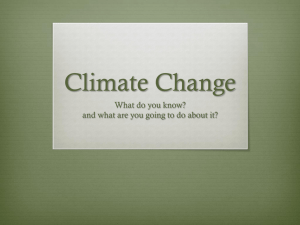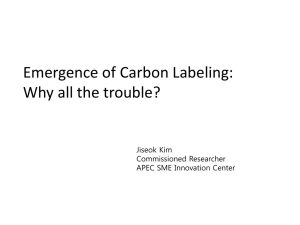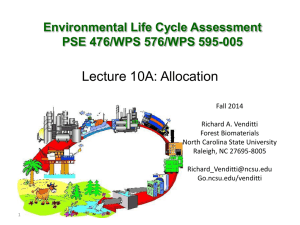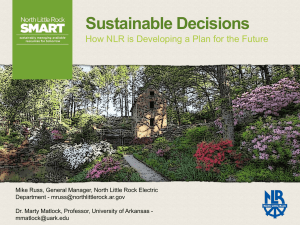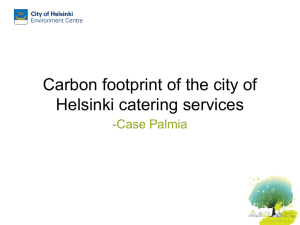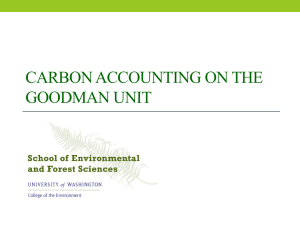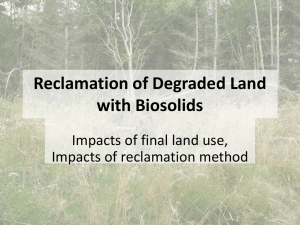Carbon Footprints
advertisement
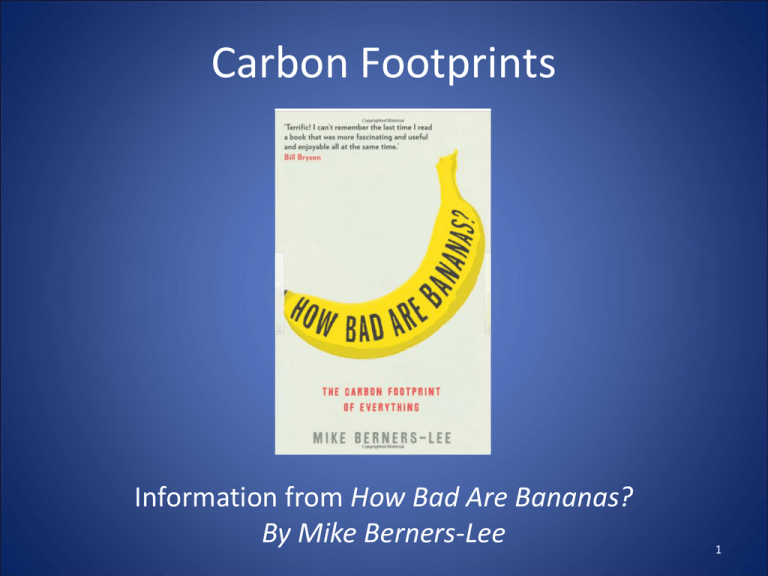
Carbon Footprints Information from How Bad Are Bananas? By Mike Berners-Lee 1 Carbon Footprint • Best estimate of full climate change impact of something – Carbon – Usually talking about CO2e (CO2-eq) not actually just carbon – Footprint – Total impact 2 CO2e • Total climate change impact of all greenhouse gasses caused by item or activity 3 Direct vs. indirect emissions • Direct emissions of an item – Manufacturing process – Transportation of item to retailer • Indirect emissions – Everything else – Example: offices in the factory use paper clips made of steel that were mined and have their own carbon footprint 4 Context for numbers • 1 gram of CO2e would be produced if you burned a pea sized blob of gasoline • 1 Kilogram (2 lbs) of CO2e would be produced if you burned 2 cups of gasoline • 1 Ton of CO2e would be produced if you burned 60 gallons of gasoline 5 Context for numbers • The average American has a carbon footprint of 28 tons CO2e / year • World GHG emissions are 34 Gt CO2e / year • The global average carbon footprint is ~6 tons CO2e / year / person 6 Carbon footprint of items • • • • • • • • • A pint of beer Cycling a mile Manufacturing a car A web search Walking through the door A banana Spending 1$ Road trip (NY to Niagara falls) 10 lbs of trash • • • • • • • • • Leaving the lights on Having a child A forest fire A Burger A bottle of water 2.5 acres of deforestation Using a cell phone A computer International flight (LABarcelona) 7 Which type of beer would have the highest carbon footprint per pint? . .. St or e bo u gh t, b oc al gh t, l bo u St or e 0% ot tl ly th e at ed w br e ly al Lo c 0% b. .. ba r 0% ed 1. Locally brewed at the bar 2. Store bought, locally bottled 3. Store bought, bottled elsewhere, imported long distances 8 Pint of beer • Locally brewed at the bar – 300g CO2e • Store bought, locally bottled – 500g CO2e • Store bought, bottled elsewhere, imported long distances – 900g CO2e 9 Which food would produce highest carbon footprint for cycling a mile? 1. Air-freighted asparagus 2. Bacon 3. Bananas na s 0% Ba na Ba co n 0% Ai r- fre igh te d ... 0% 10 Cycling a mile • Powered by bananas – 65g CO2e • Powered by cereals with milk – 90g CO2e • Powered by bacon – 200g CO2e • Powered by cheeseburgers – 260g CO2e • Powered by air-freighted asparagus – 2,800g CO2e – A hummer has a lower carbon footprint per mile 11 The carbon footprint of manufacturing a new car is ____ compared to the carbon footprint of driving that car over its lifetime 1. Very small 2. Roughly equivalent 3. Very large ar yl qu iv ye Ro ug hl Ve r a. .. al sm Ve ry 0% ge 0% l 0% 12 A new car • Citroen C1, basic spec – 6 tons CO2e: • Ford Mondeo, medium spec – 17 tons CO2e: • Land Rover Discovery, top of the range – 35 tons CO2e: • The CO2e emissions associated with producing the car are comparable to the CO2e emissions out of that car’s tailpipe over its lifetime 13 A web search • Goggle estimates 0.2 g CO2e for the electricity it uses when you enter a search term • 0.1g CO2e for 20 seconds of use from an efficient 20 watt laptop • Local network and servers would use 0.1 g CO2e • Maintenance on the whole system (replacing parts ect.) doubles the above figures • Total = 0.8 g CO2e 14 A web search • Desktop computers are more power Hungary – ~150 watts – 0.75 g CO2e for 20 seconds of use – Increases in maintenance and network CO2e – Total = 4.5 g CO2e • Google accounts for just 0.2 g CO2e of that (4%) 15 A web search • Searching the web non-stop for a year – 5 tons CO2e • Does not include – – – – Wearing clothes Keeping warm Burning calories Getting closer to your next need for medical attention – Living in a building that needs maintenance – Ect. 16 Walking through a door • Automatic door – 6.5 feet wide by 8 feet high – Stays open for 18 seconds • Power from electric motors to open door is 1 g CO2e – If the temperature inside is equal to that outside then this is the entire carbon footprint – If it's cold outside (say 20°f) then the footprint jumps to 84 g CO2e because of the energy required to heat that air 17 Bananas • Bananas have very low carbon footprints compared to other foods – Grown in natural sunlight (not in a heated greenhouse) – They don’t spoil quickly • So instead of shipping them by plane, you can ship them by boat (1% the carbon footprint of flying) – No packaging • Total = 80 g CO2e if shipped from across the world 18 Spending 1$ • In our current energy system it is very difficult to spend a dollar without it adding to your carbon footprint 19 Spending $1 • Exception would be spending on something that reduces net emissions – Minus 220 kg (485 lbs) CO2e on a well executed rainforest preservation project – Minus 2 kg (4.4 lbs) CO2e on solar panels 20 Spending $1 • In the middle of the spectrum would be spending on groceries – 620 g (1.37 lbs) CO2e per $1 • Flying is among the worst activities for carbon emissions – 10 kg (22 lbs) of CO2e per $1 21 Road trip • San Francisco to LA and back (~800 miles) – Banana powered bike • 53 kg (117 lbs) CO2e – Bus • 66 kg (146 lbs) CO2e – Small efficient car • 330 kg (728 lbs) CO2e – Plane • 500 kg (1,100 lbs) CO2e – Large SUV • 1,100 (2,530 lbs) CO2e 22 10 lbs of trash • The average US citizen sends 1,250 lbs of garbage to landfills each year • The average US citizen recycles 640 lbs of garbage each year • Landfill emissions are produced when the garbage decomposes (methane) • Sending metals, glass, plastics and paper to landfills (rather than recycling them) forces new materials to be produced for future products – It takes much more energy to make a new product from raw materials than it does to make one from recycled materials 23 10 lbs of trash • Garden waste – 910 g (2 lbs) CO2e • Average trash contents – 3.1 kg (7 lbs) CO2e • Aluminum and copper – 41 kg (90 lbs) CO2e 24 Leaving the lights on • Light on continuously for 1 year • Depends on where you are – Iceland produces almost all of its electricity from fossil fuel free geothermal and hydroelectric power plants – The US produces much more of its electricity from fossil fuels 25 Leaving the lights on • Assuming US electricity generation – Low energy bulb • 1 year • 90 kg (198 lbs) CO2e – 100-watt incandescent bulb • 1 year • 500 kg (1,100 lbs) 26 Having a child • The decision to reproduce ends up being one of the biggest carbon choices people ever make – Assuming that the child lives to 75 – Assuming the child lives a nationally typical lifestyle – Assuming that GHG emissions are reduced in the coming decades • 700 tons CO2e – 150 tons for a carbon conscious child – 2,000 tons for high-impact child 27 A forest fire • If you chose to start a forest fire – One of only decision you could make that has a larger carbon impact than having a child – Your lifetime carbon footprint would increase by 1000s of times • 2008 California forest fires – 231 million tons CO2e • A certain portion of the carbon releases will be taken back over time as the forest regrows 28 A bottle of water • Most emissions come from packaging and transport – 80 g CO2e just from the plastic 29 A bottle of water • Locally sourced and using local distribution – 110 g CO2e • Traveling 600 miles by road – 215 g CO2e • Bottled water is 1000X more carbon intensive than tap water • The world consumes 53 billion gallons of bottled water a year which accounts for 1/6th of a percent of TOTAL world GHG emissions 30 2.5 Acres of Deforestation • 32 million acres of rainforest are cleared per year – 17 percent of all human emissions • Why? – 35-45% Small farms – 20-25% for cattle grazing – 15-20% Intensive agriculture – 10-15% logging – ~5% other (urbanization, mining, roads, ect.) 31 2.5 Acres of Deforestation • 2.5 acres = 1 Hectare –500 tons of CO2e • Equivalent to driving the average car 28 times around the world 32 A Burger 33 The energy that you use to live and move around came from the sun. Which is a more efficient way to transfer energy from the sun to you? 1.: 2.: 60% 3. 1 and 2 are equal 30% 1a nd 2 ar e eq ua l : : 10% 34 A Burger • Animal products tend to be more carbon intensive than vegetables and grains because animals consume a lot of energy just to keep themselves warm and move around • Converting animal feed into meat and milk is inherently inefficient 35 A Burger • In addition to being inefficient… – Cows/sheep are ruminants • They belch out methane (CH4) • Beef/lamb has double the carbon footprint (per kilogram of meet) of pork – Excessive demand for meat provides an incentive for deforestation to provide more grazing land 36 A Burger • Beef cheeseburger – 2.5 kg (5.5 lbs) CO2e • Veggie Burger – 1 kg (2.2 lbs) CO2e • If you ate nothing but cheeseburgers for a year, your carbon footprint from food alone would be 4.6 tons CO2e 37 Using a cell phone • Depends on how often you use it • Components of footprint – Manufacturing of phone • 16 kg (35 lbs) CO2e – Power over 2 years • 6 kg (13 lbs) CO2e – Energy required to transmit calls across network • 66 kg (146 lbs) 38 Using a cell phone • 1 minute cell-to-cell phone call has the same carbon footprint as an apple = 39 Using a cell phone • As of 2009 there were 2.7 billion cell phones in use (almost half the world) • Cell phone calls account for about 125 million tons CO2e – 1/4th of a percent of global emissions • Texting is a much lower carbon option 40 Using a cell phone • A year’s typical usage of just under 2 minutes per day – 47 kg (103 lbs) CO2e • A year’s usage of 1 hour per day – 1,250 kg (2,760 lbs) CO2e 41 A Computer • Machine itself – 2010 21.5-inch iMac • 720 kg (1,590 lbs) CO2e • Electricity consumption – 2010 21.5-inch iMac • 69 g (0.2 lbs) CO2e per hour • Use of servers and networks – 55 g (0.1 lbs) CO2e per hour • Overall computing may be only a few % of your carbon footprint 42 A Computer (and using it) • Most of the manufacturing footprint comes from the microprocessor • The electricity emissions typically equal the footprint of manufacture after 15,000 hours – 9 hours every day for 5 years 43 An International Flight • Economy class – 3.4 tons CO2e • Average – 4.6 tons CO2e • First class – 13.5 tons CO2e • One trip is equivalent to 340,000 disposable plastic bags 44 An International Flight • First class tickets are particularly high in impact because the seat uses up more of the plane and by paying more money you provide more of a commercial incentive for the flight 45 An International Flight • When a 747 takes off about 1/3 of its weight is fuel • As the fuel burns, it creates 3 times its weight in CO2 46 Carbon footprint ranking 1) Forest fire – 100 million tons CO2e 2) Having a child – 700 tons CO2e 3) 2.5 Acres deforestation – 500 tons CO2e 4) A new car – 17 tons CO2e 5) Flight (LA to Spain) – 4.6 tons CO2e 6) A new computer – 720 kg CO2e 7) Road trip: SF to LA – 500 Kg CO2e 8) Light on for a year – 400 kg CO2e 9) $100 on groceries – 62 kg CO2e 10) Moderate cell phone use (year) – 47 kg CO2e 11) 10 lbs of trash – 3.1 kg CO2e 12) Beef cheeseburger – 2.5 kg CO2e 13) A pint of beer – 500g CO2e 14) Bottle of water – 200g CO2e 15) Cycling a mile – 100g CO2e 16) Banana – 80g CO2e 17) Walking through a door – 10g CO2e 18) A web search – 2g CO2e 47
